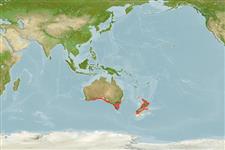Environment: milieu / climate zone / depth range / distribution range
Ecologia
marinhas; estuarina bentopelágico; intervalo de profundidade 22 - 400 m (Ref. 58489). Temperate; 32°S - 51°S, 115°E - 179°E
Southwest Pacific: confined to Australian and New Zealand seas.
Length at first maturity / Tamanho / Peso / Idade
Maturity: Lm 37.5, range 30 - 40 cm
Max length : 76.0 cm TL macho/indeterminado; (Ref. 9002); common length : 50.0 cm TL macho/indeterminado; (Ref. 9258); peso máx. Publicado: 4.0 kg (Ref. 9988); Idade máx. registada: 15 anos (Ref. 9072)
Adults inhabit continental shelf and slope waters (Ref. 6390). Reported from depths between 22 m (Ref. 58489) and 400m (Ref. 30458). They are schooling species, usually aggregating close to the sea bed (Ref. 26498) although there is some evidence that they move into the middle water column at night (Ref. 30459). Juveniles recorded offshore to a depth of 100 m and sometimes entering estuaries, often in association with jellyfish (Ref. 9563) and schooling close to the surface. Feed mainly on salps but also takes euphausiids, krill, crabs and small squid (Ref. 9072). Marketed fresh and frozen; eaten steamed, fried, broiled, boiled, microwaved and baked (Ref. 9988).
Determinate annual fecundity. Females spawn three batches of eggs in a season (Ref. 86821).
Kuiter, R.H., 1993. Coastal fishes of south-eastern Australia. University of Hawaii Press. Honolulu, Hawaii. 437 p. (Ref. 9002)
Categoria na Lista Vermelha da IUCN (Ref. 130435)
Ameaça para o homem
Harmless
Utilização humana
Pescarias: espécies comerciais; peixe desportivo: sim
Mais informação
ColaboradoresFotografiasStamps, Coins Misc.SonsCiguateraVelocidadeTipo de nataçãoÁrea branquialOutras referênciasCérebrosVisão
Ferramentas
Relatórios especiais
Descarregue XML
Fontes da internet
Estimates based on models
Preferred temperature (Ref.
123201): 11.8 - 16.6, mean 14.4 °C (based on 98 cells).
Phylogenetic diversity index (Ref.
82804): PD
50 = 0.5156 [Uniqueness, from 0.5 = low to 2.0 = high].
Bayesian length-weight: a=0.00891 (0.00406 - 0.01955), b=3.10 (2.91 - 3.29), in cm total length, based on LWR estimates for this (Sub)family-body shape (Ref.
93245).
Nível Trófico (Ref.
69278): 3.7 ±0.43 se; based on food items.
Resiliência (Ref.
120179): Médio, tempo mínimo de duplicação da população 1,4 - 4,4 anos (K=0.19; tm=3-4; tmax=15).
Prior r = 0.65, 95% CL = 0.43 - 0.97, Based on 2 stock assessments.
Fishing Vulnerability (Ref.
59153): Moderate to high vulnerability (50 of 100).
Climate Vulnerability (Ref.
125649): Very high vulnerability (77 of 100).
Nutrients (Ref.
124155): Calcium = 17.4 [12.1, 31.0] mg/100g; Iron = 0.272 [0.175, 0.434] mg/100g; Protein = 17.5 [15.7, 19.4] %; Omega3 = 0.669 [0.393, 1.167] g/100g; Selenium = 19.4 [9.7, 34.5] μg/100g; VitaminA = 22.4 [9.6, 57.7] μg/100g; Zinc = 0.533 [0.408, 0.702] mg/100g (wet weight);
